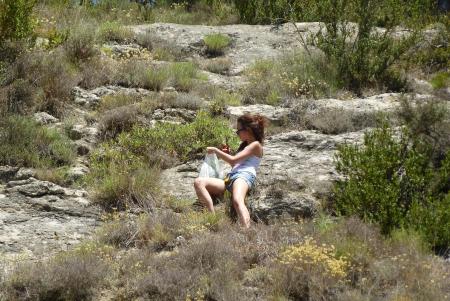
Objective:
With the aim of knowing the quality and geographical distribution of some aromatic and medicinal species used at industrial level of the Spanish autochthonous flora, for some years projects were carried out for prospecting wild populations of Rosmarinus officinalis, Thymus vulgaris, Salvia lavandulifolia and Lavandula latifolia among others.
The purpose of these projects was to find quality plant material of these species with which to start breeding work in order to obtain commercial varieties adapted to our soil and climate conditions and make them available to the agricultural sector.
Context:
The large-scale production of medicinal and aromatic plants (MAP) oriented to sell the product (either dry plant or essential oil) in bulk to industry, requires knowledge of the plant material with which it is working. One of the disadvantages of wild collection of MAP on a large scale is the variability of the plant material obtained, therefore, the cultivation of those species with more demand is a necessity. In order to implement large-scale cultivation, commercial varieties that guarantee certain yields and qualities must be available. The attainment of these varieties is the result of improvement work from wild populations prospected.
Contacts:
Roser Cristóbal Cabau, roser.cristobal@ctfc.es, www.ctfc.cat
Further information:
David Herraiz-Peñalver, Jaime Usano-Alemany, Joaquin Cuadrado, Maria José Jordán, Vanessa Lax, José Antonio Sotomayor, Jesús Palá-Paúl. 2010. Essential oil composicion of wild population of Salvia lavandulifolia Vahl. From Castilla-La Mancha (Spain). Biochemical Systematics and Ecology 38, pg: 1224-1230.
David Herraiz-Peñalver, María Ángeles Cases, Federico Varela, Paloma Navarrete, Raúl Sánchez-Vioque, Jaime Usano-Alemany. 2013. Chemical characterization of Lavandula latifolia Medik. Essential oil from Spanish wild populations. Biochemical Systematics and Ecology 46, pg: 59-68.
Jaime Usano-Alemany, Jesús Palá-Paúl, David Herráiz-Peñalver. 2016. Essential oil yields and qualities of different clonal lines of Salvia lavandulifolia monitored in Spain over four years of cultivation. Industrial Crops and Products 80, pg:251-261.
A. Cases, B. Pérez, P. Navarrete, E. Mora, B. Peña, A. Peluzzo, R. Calvo, D. Sánchez de Ron, F. Varela. 2009. Variability in the chemical composition of wild Thymus vulgaris L. Proc. Ist IC on Culinary Herbs. Acta Hort. 826, pg:159-165.
Varela R., Hernán G., Navarrete P., Pérez B., Pérez-Mao D., López-Cepero Pl, Cuadrado J., Herraiz D., Usano-Alemany J., Sotomayor J.A., Jordán M.J., Cristóbal R., Fanlo M., Melero R., Moré E., Cabot Pl, Asensio S.-Manzanera, M.C., Asensio Vegas C., Martín H., Herrero B., Fernández M., Peluzzo A., González Benito M.E., Pérez F., Sánchez D., Cases M.A. 2009. Bioprospecting: genetic resources of medicinal and aromatic plants in Spain.
F. Varela, P. Navarrete, R. Cristóbal, M. Fanlo, R. Melero, J.A. Sotomayor, M.J. Jordán, P. Cabot, D. Sánchez de Ron, R. Calvo A. Cases. 2009. Variability in the chemical composition of wild Rosmarinus officinalis L. Proc. Ist IC on Culinary Herbs. Acta Hort. 826, pg: 167-174.